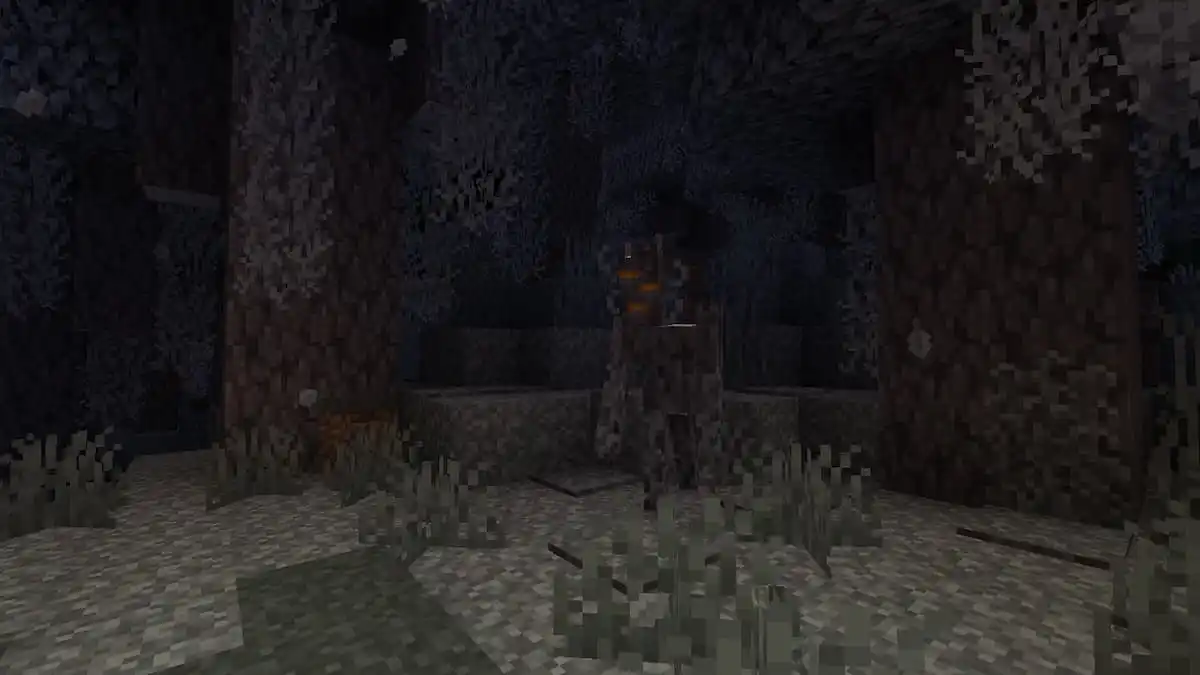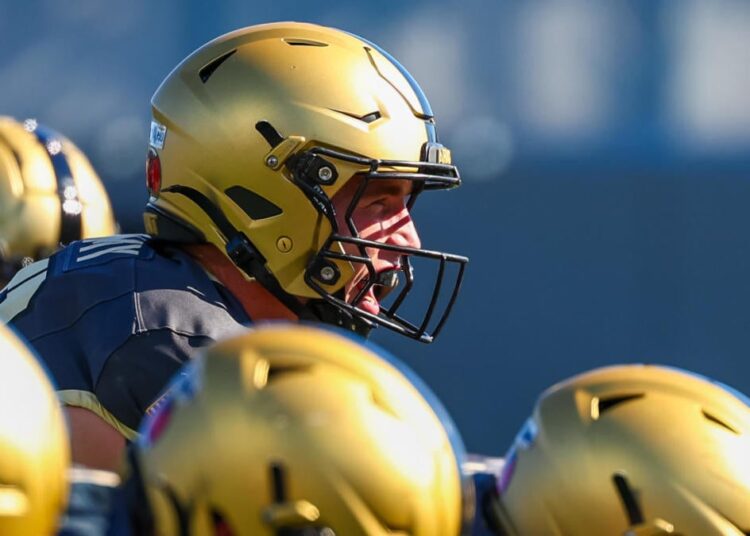WEST POINT, NY — Nine games into the 2023 season, Army head coach Jeff Monken realized he had a problem. Despite beating rival Air Force by 20 points as an 18-point underdog, the Black Knights had lost the five games leading up to that, including to UMass, which it beat by 37 points in 2022. They’d dropped the season opener to the Louisiana-Monroe team they’d beaten by 24 in 2022.They were blown out by LSU. Something had to change.
This was already a radically different season for Army, as they had transitioned from the system that has defined service academy offense for decades — under center, majority flexbone — to a shotgun-only spread/RPO offense.
Whereas in the past, Army looked like this:
They transitioned to look like this, similar to just about about every other team in the country:
“We got shut out 62-0 by LSU. They’re a good team — we’ve played a lot of teams like that in my tenure here — we never lost like that. I was talking to [LSU head coach] Brian Kelly before the game, [he asked] ‘why did you change?’ and I told him why,” Monken said in an interview with CBS Sports. “I could tell there wasn’t any disappointment in his voice.”
Army had become straightforward to defend. It ran counter to a saying offensive coordinator Cody Worley has: “you gotta be different or you gotta be better.” It’s difficult for Army to be better athlete-for-athlete with many of the teams it faces because of its recruiting challenges, but by being different they could go toe-to-toe with teams like LSU and 2018 Oklahoma team, a future College Football Playoff squad Army took to overtime in Norman.
By lining up just like everybody else, Army relinquished its edge by not being different enough. Ahead of No. 21 Army’s clash vs. Air Force on Saturday (12 p.m. ET, CBS), here’s how the Blake Knights got their edge back.
Out of the reasons Army made the schematic change, one stands out the most: the rivalry against the other service academies. For Army, the Air Force and Navy games are the hardest to win every season. Monken described those games to Sports Illustrated as a fight in which “You each get a sledgehammer and you hit him as hard as you can with a sledgehammer, and then he gets to hit you back with his sledgehammer, and then you hit him back with a sledgehammer, and the last one standing wins.” Army needed to be different on offense first and foremost to gain an advantage in those two games, and ironically, that part actually worked. Army dominated Air Force and later Navy at the end of the 2023 season to win the Commander In Chief’s Trophy, but in the other games that season, they were nowhere near the standard Monken had for the program.
Switching to the shotgun-based attack involved bringing in a new offensive coordinator at the time, Drew Thatcher, from Division II. It changed how the offensive line blocked, taking players out of four-point stances and into three-point stances. Army also switched to work around a 2022 rule change that made it impossible to block below the waist outside of the tackle box, or beyond a lineman’s “initial blocking movement,” which they found out about near the end of spring practice that year. Cut blocking was particularly beneficial for Army which typically carried smaller players. Army’s coaches now admit it was too much of an overcorrection. In many ways, the offense in 2023 was almost too new. Army often benefited from the rolodex of knowledge coaches who had been together for a long time under Monken winning a certain way shared.
“I think that’s what hurt us last year, we had [no institutional knowledge],” co-offensive coordinator Matt Drinkall said. “It was new everything.”
The Black Knights ranked 100th or worse nationally in just about every efficiency metric like success rate, three and out percentage, and red zone touchdown rate. They had 34 plays gain 20 or more offensive yards. In 2024, they have 41 such plays through seven games. Army was almost exclusively an under center team hovering around 90% of their snaps year-in, year-out. The shift was so drastic in 2023 that the only plays they had run under center up until the Holy Cross game in mid-November were kneel downs. It was to the point that Army hadn’t practiced under center all year. But that week, Monken decided to sprinkle in some under center plays back into the mix.
“He called the first play in practice, and it looked like we’d been doing it all season,” quarterback Bryson Daily said.
They ran a handful of them in a close win over the Crusaders, and the day after, Monken decided they’d put a full under center package in the offense. That changed by Monday.
“I said, ‘I don’t know if we can stay in it, but I want to start the game in it,'” Monken said. “And I said, ‘I want Cody to call [the plays], because he understands it, knows it, he’s got to call it.’ So we practiced that week under center plays, probably one under center play for every two gun plays.”
Worley had only called plays once in his career back in a 2020 bowl game against West Virginia. That week, multiple coaches tested positive for Covid-19 and Worley himself didn’t test negative until the day before Army flew out to Memphis for the Liberty Bowl. Worley had previously been at Kennesaw State and the Citadel and has a deep familiarity with option football.
“I screw around on guitar, right? Not very good, but I love playing, and I go on YouTube, and I watch Clapton and Mark Knopfler from dire straits, and these guys play guitar, and it’s like it’s a part of them,” Drinkall said. “That’s how Cody is with option football. When you watch him call the game he understands it like it’s an organ, like it’s a part of him.”
Army didn’t just go under center for one drive. After a 13 play, 75-yard scoring drive that took eight minutes off the clock to start the game, Army stayed under center for 63 of the game’s 64 offensive plays with plenty of flexbone staples like the fullback dive and the triple option. Not only did they win, but they won Monken’s way: dominating the time of possession battle 40:00-20:00, blocking a punt for a touchdown, bend-don’t-break defense that forced a turnover in the red zone and only two passes attempted. They ran the ball 62 times at a 5.9 yards per rush average, both high-water marks against FBS teams in 2023.
The concept of halftime adjustments can be at times overstated on broadcasts or by coaches and players, but Army came into that game with about five total plays under center. During the intermission, they added two formations and three plays in the locker room based on looks Worley saw during the first half. They came out of the half and immediately generated two explosive plays on recently installed plays, including the score that ended up putting them up 28-14, giving them the breathing room they needed to win 28-21. It was a play they’d run in the option past that hadn’t been practiced in nearly a year.
From there, Army briefly returned to the shotgun-based attack to remain different enough to win the sledgehammer contest against Navy, which they did, but in the offseason the work began to find a blend between old and new, and that involved making sure the rhythm of the offense was in the right place. Thatcher moved on, and Worley was promoted to permanent offensive coordinator and the hybridization of the offense began.
It may seem simple, but toggling between the flexbone and the shotgun changes the pacing of plays. The flexbone isn’t just a formation, it can be an entire offensive system unto itself. Flexbone offensive line technique essentially means the offensive line falls forward out of a four point stance. That works for a quick-hitting option run under center with the quarterback reading unblocked defenders. That doesn’t work so well with a shotgun run play that takes longer to develop and it’s even less suited for a dropback pass.
Where Army really shines now is in the presentation. Offensive football at its core is making the exceedingly simple look extremely complex. When Army lined up in a shotgun formation every play, there was no reason for LSU to line up much differently against them than they did against Alabama. Without Alabama’s level of talent, Army was fighting an uphill battle. Now, Army has the system tuned to run its core concepts under center or in the shotgun and it’s their presentation that still creates conflict. Because they will get in an under center look like this:
And while they still will still run the triple option sometimes, other times they won’t, which keeps the threat of it in the back of the defense’s mind when they run something else, like this quarterback counter by Daily.
“I’ve always wanted to be a hybrid,” Worley said. “What we did last year combined with kind of what we’ve done in years past, and of merging the two to where the biggest thing that we discussed, and I didn’t want two different offenses. I didn’t want the guys to feel like we have this gun offense and we have this under center offense. So a lot of the core things that we do, there’s carryover. So you’re banking reps whether you’re under center or in the gun. And so our guys, besides the quarterback and the center, a lot of times, they may not even realize there’s any difference. Whether it’s a game where we’re majority gun and or a majority under center, it’s really based on what we need to do to be successful.”
Monken says he’s glad for the experience last year and admits his staff learned a lot from it. With a better offensive system in place, the Black Knights are back to winning ways and have started the season 7-0. They’re yet to face a team with a winning record, but dates with North Texas, Notre Dame and Navy await. Army is back to being different now, and they’re better because of it.
Read the full article here


























Discussion about this post